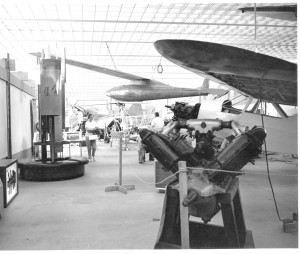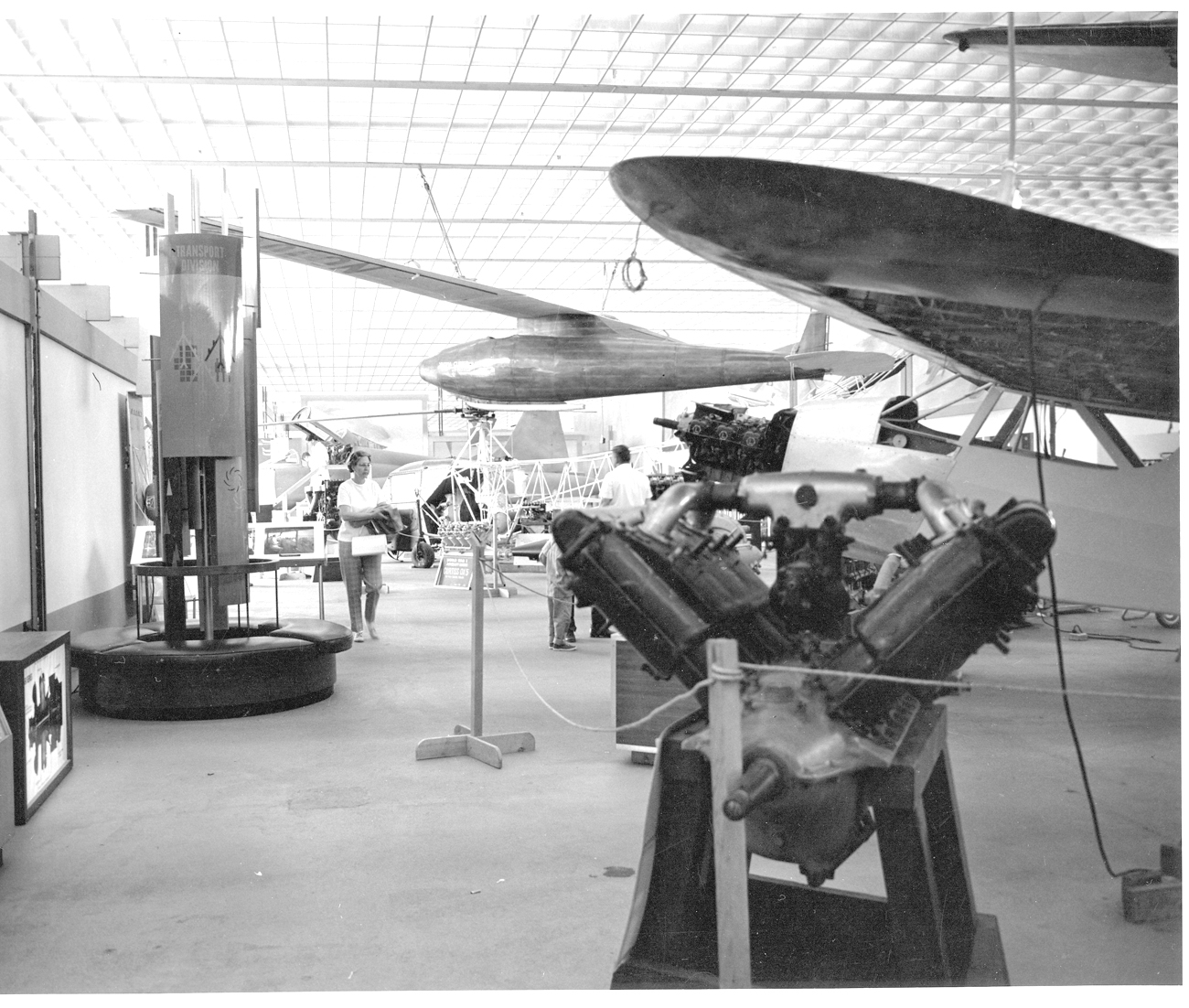By Candice Tewell

A visitor enjoys the 10,000-square-foot Museum of Flight display at Seattle Center created by the Pacific Northwest Aviation Historical Foundation. The exhibit first opened in 1968.
The Museum of Flight celebrates an important landmark this year; it has officially reached middle-age. That’s right, the museum is turning 40! As the birthday approaches, it’s appropriate to review some of the milestones in the growth of this world-class institution and to take a peek at what the future may hold.
The history of The Museum of Flight is a “trash to treasure” story—literally—as it was the discovery of the battered carcass of a 1929 Boeing 80A-1 in a landfill in Anchorage, Alaska, that prompted several aviation enthusiasts from the Seattle area to create the Pacific Northwest Aviation Historical Foundation. Formed in 1965, with the dual goals of preserving aircraft and related artifacts in the Northwest and of fostering public knowledge and education related to aviation, PNAHF’s first project was to recover and restore the 80A-1. This all-volunteer effort took place over a 16-year period, and the fully restored Jazz Age airliner—the only one of its type in existence—is now a centerpiece of the museum’s Great Gallery.
In 1968, only three years after the creation of PNAHF, the first public exhibits were opened under the “Museum of Flight” name in a 10,000-square-foot rented space at Seattle Center, the publicly owned exhibition area built for the 1962 World’s Fair. Though many Seattleites still cherish fond memories of the fledgling museum at Seattle Center, the space was cramped and unheated, making it an inconvenient and unhealthy home for large and fragile aircraft and related artifacts. Planning began at that time for a permanent home for the museum.
To celebrate its tenth anniversary, the museum acquired its first permanent home, the Red Barn, the original manufacturing facility of The Boeing Co. The 1909 all-wooden structure had been abandoned by Boeing following World War II and had come into the possession of the Port of Seattle, which planned to raze the building. The Port sold the Red Barn to the museum for $1, and the structure was barged approximately two miles up the Duwamish River to its current location on King County International Airport/Boeing Field.
Work to restore the Red Barn got a boost in 1978, when the building was designated to the National Register of Historic Places in recognition of its status as the oldest aircraft manufacturing plant in the United States, as well as one of the largest all-wooden factory buildings remaining west of the Mississippi River. The restoration began in 1980, as the first part of the two-phase Museum of Flight expansion and improvement program.

The Red Barn was barged one and a half miles up the Duwamish River from its original location to Boeing Field in 1975. It became the first permanent home of The Museum of Flight when it opened to the public in 1983.
The newly restored “William E. Boeing Red Barn” opened to the public in 1983. That same year, the museum launched a capital campaign for the second phase of the project, the construction of the T.A. Wilson Great Gallery. Groundbreaking for the Great Gallery occurred in 1985, during the celebration of the museum’s twentieth year, and in 1987, then-Vice President George H.W. Bush cut the ribbon on this dramatic, three-million-cubic-foot steel-and-glass facility. Currently, the gallery’s innovative space-frame ceiling supports 23 suspended full-size aircraft, the heaviest of which—the Douglas DC-3—weighs more than nine tons.
Education has long been an important goal of The Museum of Flight. From the beginning, the museum has enriched the local community with educational exhibits and programs. In 1992, the museum’s youth education programs received a significant boost with the completion of the Challenger Learning Center. This experiential learning facility consists of realistic, interactive mock-ups of a NASA-style mission control room and a spacecraft in which teams of students work together to perform experiments and solve problems on a simulated space mission.
The next phase of museum expansion—the Museum Store, the 132-seat Wings Café, the 250-seat Skyline Room banquet and meeting facility, and the state-of-the-art catering kitchen—were completed in 1994, bringing the museum’s total square footage to 185,000. That same year, one of the museum’s most popular and widely recognized artifacts was installed on the floor of the Great Gallery, as the restored Lockheed M/D-21 Blackbird spy plane and drone were unveiled. By its thirtieth anniversary in 1995, the museum had grown to become one of the largest air and space museums in America.
The next year, another major artifact was delivered to the museum’s front door—literally. The first jet “Air Force One,” a Boeing VC-137B first delivered to President Dwight D. Eisenhower in 1959, was acquired on long-term loan from the U.S. Air Force. Now located along with the Boeing 737 and 747 prototypes—as well as the only supersonic Concorde on the West Coast—in the museum’s Airpark outdoor display gallery, Air Force One remains one of the museum’s most compelling exhibits.
A year later, in 1997, the museum opened the world’s first full-scale, interactive air traffic control tower exhibit. Taking advantage of the museum’s location on one of the 30 busiest airports in the nation, the exhibit gives visitors a glimpse into the fascinating air traffic control system with real-time feeds from actual FAA installations.
More recent major permanent exhibit openings include Rendezvous in Space: A Tribute to Pete Conrad, opened in 2000; the youth-oriented Flight Zone, opened in 2001; and the Birth of Aviation Wright Brothers exhibit, opened in 2004. Indicative of the museum’s vision, all three of these exhibits are highly interactive, using multimedia and simulation technologies as well as hands-on elements to provide visitors with the chance to experience the wonder of air and space flight.
The latest quantum leap in the museum’s facility and vision is represented by the 88,000-square-foot Personal Courage Wing, which opened June 6, 2004. This addition presents 28 World War I and World War II fighter aircraft—including most of the famous Champlin Fighter Collection—in dramatic, interactive exhibits. It increased the museum’s gallery space by nearly 50 percent and has cemented the museum’s position of eminence among the world’s great air and space museums.
Education continues to be a priority at the museum as it enters its fortieth year. As reported in the September 2004 issue of this paper, the museum’s Aviation Learning Center officially opened its doors to young and old alike this past fall. Participants in this new experience, which was developed entirely in-house by museum staff and volunteers over a several-year period, spend two hours immersed in computer-assisted learning, hands-on activities and virtual-reality simulation as they explore a day in the life of a general aviation pilot. A genuine, full-size Cirrus SR20 generously donated by the Minnesota-based manufacturer is the centerpiece of this exciting new facility that the museum hopes eventually to replicate at other institutions across the country.
As we turn to look at the museum’s future, the outlook is for continued growth and change. The museum is expanding its reach to the north through participation in the new Future of Flight Aviation Center and Boeing Tour (formerly the National Flight Interpretive Center) at Paine Field in Everett, Wash. A joint venture among The Museum of Flight, Snohomish County and The Boeing Co., Future of Flight is scheduled to open in August of this year with exciting historical and future-focused exhibits, multimedia experiences and a revamped and revitalized version of the popular Boeing Everett Assembly Plant tour. The museum will operate the county-owned and Boeing-leased facility, and museum staff members are currently working closely with their Snohomish County and Boeing counterparts to create a unique visitor experience for this innovative, one-of-a-kind facility.
The museum is also expanding to the south. The purchase in 2000 of the Champlin Fighter Collection made the dream of the Personal Courage Wing a reality, but it also created a new opportunity to reopen the former Champlin Fighter Museum in Mesa, Ariz., in a new guise. Although many details remain to be worked out, look for the new Arizona Museum of Flight to open in the coming months, featuring the fascinating story of the jet fighter and those who flew it. The museum is thrilled at the prospect of engaging the many aviation enthusiasts who live in and visit the Phoenix area.
Finally, dreams of expansion at the museum’s Boeing Field location are far from complete. Ambitious future plans call for the construction of at least two more major structures on the museum’s existing property—a “Red Barn Pavilion,” that will completely enclose and protect the Red Barn while also creating new gallery space and a dedicated Education Center, and a “Commercial Aviation Wing and Space Gallery” that will house the very large aircraft of the museum’s airliner collection as well as items from the museum’s ever-growing space collection. As this is written, the museum board of trustees is evaluating which of these two phases to tackle next and when to begin.
For 40 years now, The Museum of Flight has prospered due to the generosity of its many individual and corporate donors, the selflessness of its thousands of volunteers, and the compelling nature of the story of flight it seeks to tell. Here’s to the next 40!
- The Personal Courage Wing, which opened in June 2004, increased the size of the museum by almost 50 percent. It contains 28 World War I and World War II fighter planes and tells the
- Construction began on the T.A. Wilson Great Gallery in 1985, and the ribbon-cutting on the three-million-cubic-foot, steel-and-glass facility took place in 1987.













